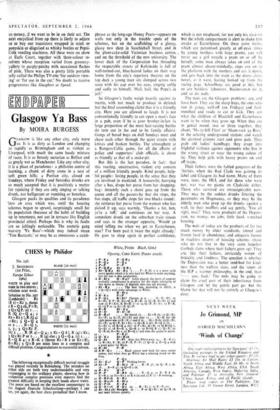Circuit and See
CONSUMING INTEREST
By LESLIE ADRIAN
A NON-TECHNICAL neigh- bour of mine recently tried to hire a television receiver that she, being elderly, could move easily from room to room. Like a lot of people, she doesn't want to have the box around all day. But the hire com- panies don't hire portables. Some of the sets are move- able all right, they even have handles, but it takes a fairly strong pair of arms to shift them with any ease. Eventually she settled for a particular model, which was sup- posed to receive all three channels, using an indoor aerial that looked remarkably like a model of the Jodrell Bank radio-telescope. She could only get a spotty smudge for BBC-2 so sent for 'the man,' who came and tuned the set beautifully to the kangaroo programme and went away. After he had gone, my neighbour tried to switch over to BBC-1, but found that all she got was a swirl of black lines. Same on ITV. Challenged, the ser- vice engineer admitted that, without an outdoor aerial, the set would never satisfactorily perform on all three channels.
When colour television arrives in 1967 on BBC-2 things are going to be even worse. Apart from the fact that colour TV is not all that Mr Paul Adorian has said it is in The Times (not to mention Mr David Attenborough all over the place) it's going to need an aerial array that will beat all the pigeon perches on all the chimney stacks in the country. Why anyone would want to spend over £300 on a colour set and another £30 to £40 on the aerial to see people with purple faces playing cricket on maroon grass beats me. Just as this stereophonic radio nonsense does. Before the assaults via two loud speakers instead of one; why not spend a little more on better programmes?
A BBC handout at the TV and Radio Show last week revealed that to receive stereo, a decoder unit is needed, if you already have a frequency modulated VHF set, and two loudspeakers, as well as an outdoor aerial. This is the kind of apparatus that the hi-fl aficionados collect, but the rest of us probably just want to hear the news and 'A Book at Bedtime,' and not have it bellowed into both ears from all over the room. One gets the impression that there is some conspiracy afoot between the Corporation and the industry to make us all spend more on unnecessary equip- ment.
By 1967, said Mr Attenborough in a lecture about BBC-2 last March, the public will get colour TV and 'we have been doing our sums with excite- ment and optimism' and 'a fair amount of guess- work . . .' My excitement is that of a customer who is far from satisfied with his pennyworth of plain and is damned if he yet wants to spend twopence on coloured. It is odd that a channel as unsuccessful as BBC-2, in spite of all the tricks that have been played on the viewers (the promise to repeat the best programmes on BBC-1 has not been kept; The Virginian is the leading example), should now launch itself into a more expensive and harder-to-receive medium than 625 lines in black and white. Apart from the colossal capital cost, guesswork and all, millions of viewers seem to be expected to junk their sets and plunge into HP debt or dearer hire arrangements to please the pundits at Broadcasting House.
As Which? pointed out in its television receiver survey in August, a 1961 set will be too costly to convert for the second channel, and even after spending £10 to £15 to convert a newer set, quality may be poor, as the 625 system suffers abominably from interference. Indeed, there is already talk of going back to 405 lines for colour or even adopting 525. But whatever the big spenders in Langham Place decide, it will cost
us money, if we want to be in on their act. The nog encyclical from up there is likely to adjure us to buy our transistors wrapped in mink or .ponyskin or disguised as whisky bottles or Pepsi- Cola vending machines. All these were on show at Earls Court, together with three-colour re- ceivers whose reception varied from greenery- yallefy to purply-patchy with occasional flashes of pink. There was also a pretty little portable telly called the Philips TV-ette 'for outdoor view- ing' or 'for use in the car.' No doubt to receive programmes like Slaughter at Speed.































 Previous page
Previous page